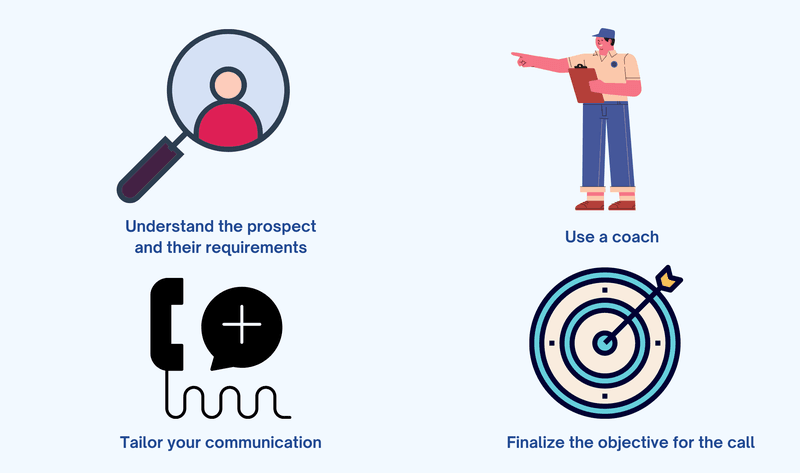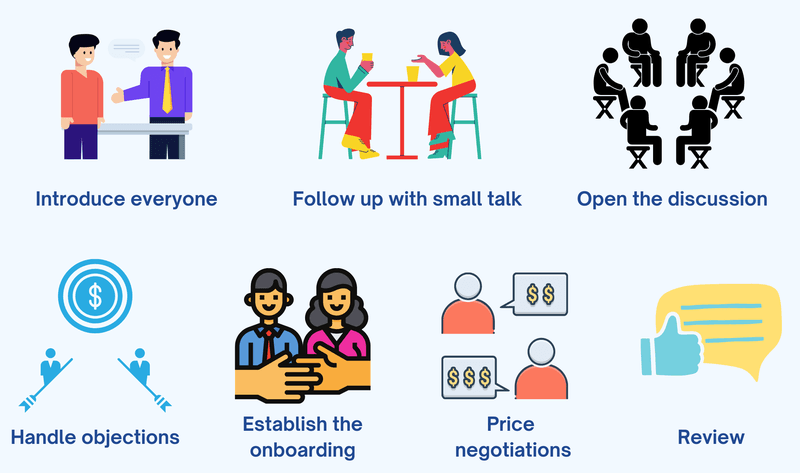Society needs a large variety of products and services to function smoothly. Individuals set up businesses, big and small, to fulfill these needs. However, the essential condition for companies to exist and thrive is that they are in the black. And finally, for that to happen, businesses need to have a steady stream of clients. This article will focus on the art and science of a successful closing call.
Here are the main questions the article will answer:
- What Is a Closing Call?
- What to Do Before a Closing Call?
- What to Do During a Closing Call?
- What Do You Do at the End of a Closing Call?
- When Is It Appropriate To Ask For The Order When Closing A Sales Call?
What Is a Closing Call?

Undoubtedly, a closing call is essential for the entire sales cycle. Reaching out to prospects nurturing them through marketing material and emails does nothing without a successful closing call.
So, the closing call is the last step in a long drawn process. While the ultimate objective of a closing call is to finalize the deal, it has several smaller parts. Let us explore the different parts of the closing call process.
What to Do Before a Closing Call?
As a sales team, a lot of hard work and meticulous planning has led to this moment- the final meeting where you are about to seal the deal. So, it is essential not to ruin the efforts.
A closing call involves a lot of background work. This is the only way to ensure that you are ready for any contingencies. Also, this enhances one’s chances of a successful closing call. This section will look at steps that need to be taken before a closing call.

Understanding the prospect and their requirements.
The team has been talking to the prospect for a while now. But the pressure of a closing call could lead to lapses in concentration.
As a result, there are chances of a mix-up between names and other account information. This is embarrassing and indicates a lack of focus.
Therefore it is essential to be familiar with all stakeholders of the potential client before getting on a closing call.
One must also evaluate if they completely understand the prospect’s requirements. The offering must solve all or at least most of the prospect’s pain points. If the team feels that it does not entirely meet the criteria, it is too early to have a closing call.
If the requirements are too complex, it is always good to have them in a visual format such as mind maps or a presentation. Also, begin the closing call with this presentation to get everyone on the same page.
Use a coach.
It always helps to have someone in the target organization that provides the sales team with the context of the industry and the team members on the prospect’s side. The sales team or at least the head must review the deal with these questions:
- Why would the organization go ahead with the product?
- Reasons for the target organization to go ahead with the product
- Why would they not choose the product?
- What possible questions or objections could be raised?
Tailor your communication.
The sales team has been working with multiple clients. This makes it highly essential to review the discussion notes from the previous meetings.
Furthermore, the team will be able to approach the closing call as per the prospect’s expectations. The sales team can set the tonality of the closing call as per the unique communication style of the client.
Finalize the objective for the call.
The sales team needs to look at the objectives for the call. This is beyond the ultimate goal of finalizing the deal. They need to look at various aspects such as –
- How many units is the prospect willing to purchase.
- The subscription plan that he is looking to opt for.
- The number of users that need to be onboarded.
- What is the start date?
- The number of training sessions that the client wants.
It is also essential to know how much the team wants to negotiate the pricing with the client.
What to Do During a Closing Call?

One has to follow several steps to brighten the chances of a successful closing call. Let us talk about them in this section.
Introduce everyone to the meeting.
Every closing call should begin with a round of introductions. It is a common courtesy. Also, this helps people familiarize themselves with all the stakeholders, and this has an added advantage that people who join the meeting late will not miss much.
This also avoids the element of surprise as any new faces at this stage of the sales process will definitely stick out.
Follow up with some small talk.
Yes, this meeting is all about clinching the deal. But it is essential to let the participants indulge in some small talk. This helps lighten the mood before getting down to business.
Also, it shows that both the parties involved have a human side. This furthers the trust and establishes a rapport between the teams involved.
Open the discussion.
Here, the aim should be to make the prospect speak as much as possible. So an ideal approach to start a successful closing call is, to begin with, a simple open-ended question.
Here, the aim should be to make the prospect speak as much as possible. A few examples of such questions are:
- What is the progress so far?
- How have the discussions with your team been so far?
The prospect’s answers to these open-ended questions are essential as they will help the sales team decide whether the potential client needs more convincing. But the most critical thing here is to let the client feel that he is ready. Also, encourage him to ask any questions that he may have.
Handle objections, if any.
Closing calls and last-minute objections go hand in hand. Some of the most common ones are:
- We do not have the business requirements for your product right now.
- “Your solution is priced above our budget.”
- “X is offering the same solution with many more features.”
Here is where the sales team’s extensive knowledge of their product vis-a-vis their competitors comes into the picture. They need to be thorough with the USP of the product at hand.
Establish the onboarding process.
When the prospect has no further questions and wants to proceed with the deal, it is time to guide him through the next stage. This includes training, onboarding, and implementation.
After this, it is advisable to take the client through the various plans, payment options, and customer support available. Subsequently, it is time to finalize the implementation plan with dates and milestones.
Price Negotiations.
This is one of the most critical components of a successful closing call. One needs to look at the offered pricing plans and understand if there is any room for negotiations. The space for negotiation depends on several factors such as:
- Type of plan opted / Number of units ordered
- Pricing of the plan
- Length of the contract
- Revenue of the firm
Review by the legal and procurement teams.
This is when other areas such as the legal and the procurement teams review the document.
When other teams are involved, specific information needs to be made clear. This includes – the point of contact from each functional area, requirements from all stakeholders, and timelines for the entire process.
What Do You Do at the End of a Closing Call?

Congratulations! You have successfully completed a closing call. The entire team is deserving of praise.
However, it would be naive to assume that your work is done. Several aspects have to be addressed at the end of a closing call. We are going to discuss these points in some detail here.
Get Started.
After you and your team have completed the closing call and all the queries from various quarters have been addressed, it is time to hit the ground running. Issue a contract and make sure that the relevant stakeholders have signed it.
The contract needs to be agreed upon and signed by the parties involved. Once this is done, the onboarding process can begin.
Also, it is a good idea if people on both sides share their contact details. This way, if the contract signatures are delayed for some reason, you can always get on a call and enquire about the roadblock.
Go through the meeting discussions.
It is always a good practice to review your journey with the recently onboarded client. After a closing call, this type of review with your sales team helps in several ways, such as:
- Reinforces the best practices that the team executed successfully.
- If the client is from a new sector that the organization has not explored before, it opens up new avenues of revenue generation.
- This review meeting prepares the team for the road ahead.
Review the onboarding plan.
Even if you have already discussed the onboarding plan with the client, It is a good idea to review it internally. This helps in understanding if the onboarding plan is realistic.
Furthermore, one can evaluate if the users will get sufficient training to get familiar with the solution. If this objective is not met, it defeats the whole purpose of onboarding.
Once the internal review is complete, the team must always run the changes past the client. This will also assist the team in understanding if the customer is ready for the onboarding.
Some organizations have a dedicated onboarding manager to ensure that smoothly the entire process is carried out. The minutes of each onboarding meeting must be noted.
If it is a virtual onboarding, the calls have to be recorded and the recordings made accessible to the team.
Provide the best possible customer support.
You have just landed a client after a grueling process. You and your team assured the client of your excellent round-the-clock customer support throughout. But once the dotted line has been linked. Poof! You vanish!
The customer support that you spoke of is nowhere to be seen. The support team does not respond to queries or is highly delayed and inconsistent.
Nothing frustrates a customer more than poor after-sales support. It is essential to set up a regular cadence and review its progress and pain points.
Share regular updates about new features and changes.
Every product is constantly evolving to meet the needs of the market. Your clients must be abreast of these changes. If needed, get on a call with them and walk them through the changes in detail.
Some methods to keep clients in the loop about modifications and new features are webinars, regular review calls, email and newsletter updates.
Cross-Sell and Up-Sell.
The new client would have only purchased one of your many offerings. It is also possible that he may have chosen the lowest possible plan amongst several available tiers.
Providing the best possible customer experience and a gentle nudge wherever the opportunity presents itself is a great way to put forth your other products.
For instance, if the client has brought a website analytics tool, you can also pitch your social media management tool if he hints that he is facing troubles managing his brand’s social presence.
Get referrals and testimonials.

Once the client has worked with the solution and the team involved for a reasonable period, say 6 -12 months, it is a great idea to ask him for a testimonial. This will enhance the standing of your product amongst the competition.
Delighted customers are also an excellent source of new business as they are very likely to refer your solution to other people in their network.
When Is It Appropriate To Ask For The Order When Closing A Sales Call?
As we know, making decisions and commitments is hard for anyone. It’s more complicated if the value involved is higher. For that reason, when is it appropriate to ask for the order when closing a sales call? It depends.
It depends on the amount involved in the sale, how committed your prospect is, and how fast he wants to go.
During your closing call, make the prospect create an attitude of making decisions and saying yes all over the call. Maybe use touchpoints about the customer’s successful results, give him self-confidence, so when you provide the final request, he would be in a better mood and habitually say yes.
When approaching the end, you need to encourage your prospect on the call with phrases such as:
“If we close the deal now, you will have this, this, and that (a benefit for closing it soon)”.
If you’ve been warming up this order on the previous calls, you can state this at the beginning of your conversation, but keep in your pocket an extra benefit:
If you sign by the end of today, I can give you XYZ (an extra benefit you’ve been keeping to offer for the closing yes).
If the prospect is too far from a decision, warm him up more on the call, mentioning your company’s experience with his needs or issues and how manageable it is for your product and service. State the “no-brainer” profitability your product can bring to the table. More likely, after a deep warm-up, you should ask for the closing of the deal at the end of the call.
In Conclusion
Closing calls are vital as they are the final step in bringing new business to your firm. One must always focus on the customer, and the problem statement brought to the table.
Also, the process is not over when the closing call is completed successfully. It is possible to have a high rate of successful closing calls if you have a well-defined sales process in place. Arguably, the most important – customer retention – starts now.

Ranu Kumari is a Professional Writer and a Marketing enthusiast who currently runs her own Marketing Consultancy, LatitudeBOX. She has written promotional articles for multiple brands and has published her work in Scopus indexed journals. She is passionate about expressing her thoughts and ideas to connect with her readers in a voice that they understand.
